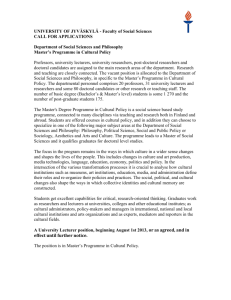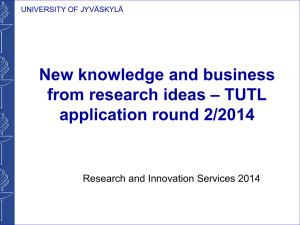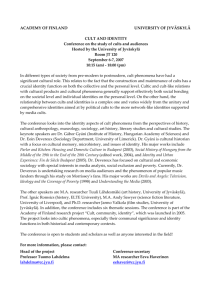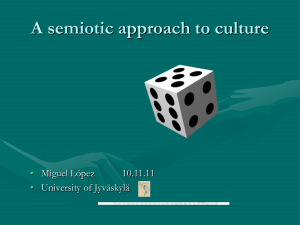Document
advertisement
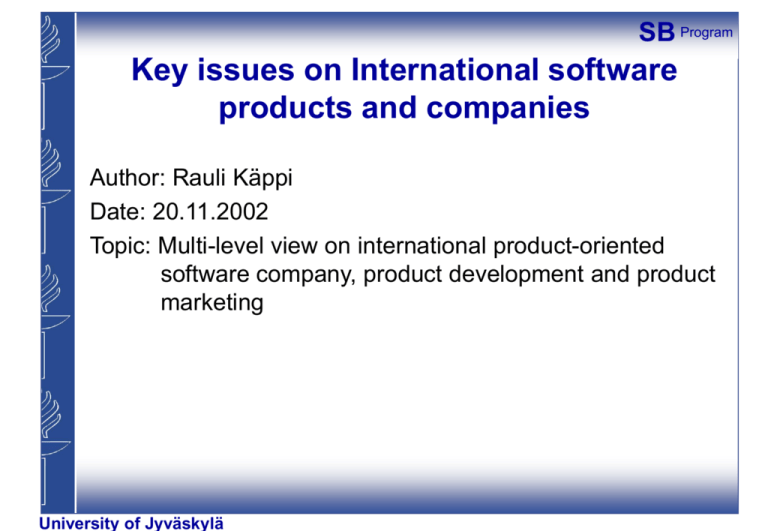
SB Program Key issues on International software products and companies Author: Rauli Käppi Date: 20.11.2002 Topic: Multi-level view on international product-oriented software company, product development and product marketing University of Jyväskylä SB Program Earlier and future research Earlier focus has been on early productisation of european, small, even start-up companies in a master’s thesis form The Ph.D. work focus is designed to progress towards more mature, larger companies (above 50 employees) using similar multi-level approach Multi-level view includes the analysis of: managerial strategy work, company’s internal processes, software product development practices and customers setting requirements University of Jyväskylä SB Program Research area description The general purpose of the research is to identify both development and marketing mechanisms, which can be deployed concurrently to provide software product companies clear, feasible ways of managing themselves while developing and selling their software products for the international market. As important is to identify common reasons for failure in the field. University of Jyväskylä SB Program Introduction The research area of software products can be categorised relating either business-to-business or business-to-consumer products. Another categorisation is the division to tailored, MOTS and COTS areas. One interest area is to find relatively detailed models and processes, which identify the relationships between new product development (NPD) processes and feasible market entry mechanisms in selected software product categories. University of Jyväskylä SB Program Product and tailoring businesses compared by Hoch et al. PRODUCT BUSINESS MARGINAL COST PROFESSIONAL SERVICES Almost constant MARKET STUCTURE Highly fragmented Highly globalized REGIONAL APPEARANCE Mainly regional, tendency to globalisation Higly globalized CUSTOMER RELATIONSHIP MOST IMPORTANT NUMBER TO WATCH RELEVANCE OF MANAGEMENT AREAS One to one One to few, one to many Capacity utilization rate Market share (installed base) Human resources Software development Marketing and sales Strategy Almost zero Strategy Marketing and sales Human resources Software development University of Jyväskylä SB Program Relations between different software business types by Käkölä (Hoch et al.) University of Jyväskylä SB Program Product and tailoring business… University of Jyväskylä SB Program Management and strategy are evaluated as key factors for product success Räsänen, H. 2001 University of Jyväskylä SB Program A generic process for creating products Trott, P. 1998 University of Jyväskylä SB Program Software company’s internal product process Käppi, R. 2002 University of Jyväskylä SB Program Whole product model Generic product – first implementation Expected product – different user groups’ needs Augmented product – with partners’ add-ons Redefined product which includes all the functionality showing market interest University of Jyväskylä By Theodore Levitt SB Program Whole product cont. Moore’s definition (Moore 1995, 21) of the whole product is more simplistic: “The minimum set of products and services necessary to ensure that the target customer will achieve his or her compelling reason to buy”. University of Jyväskylä SB Program Geoffrey Moore’s work Crossing the Chasm Inside the tornado Both books offer a comprehensive view on marketing and product strategy Moore is one of the first succesful writers who has concentrated on ITC-products and companies University of Jyväskylä SB Program Geoffrey Moore cont. Innovators and technology enthusiasts (techies) are characterized as “those who appreciate the technology for its own sake”, or as “Gyro Gearloose (Pelle Peloton in Finnish). They do not require a high level of productization; instead they are more interested in the architecture and technical features and benefits of the product. Companies with such type of enthusiasts are typical customers of software products in their early development stages. University of Jyväskylä SB Program Geoffrey Moore cont. The second group of customers is the early adopters, visionaries. They are characterized as “people who have the insight to match an emerging technology to a strategic opportunity.” This group is still not requiring very highly productized solutions, although the requirement level is clearly higher than in the first group. The risk in this group is that they may want things that are not consistent with the product concept sellable to other customers. University of Jyväskylä SB Program Geoffrey Moore cont. The third group, the early majority, pragmatists are people within the buyer company who do not want to be pioneers in the technology adaptation. They are characterized as more like the X-files’ Scully than Mulder, or more like Lethal Weapon’s (Tappava ase in Finnish) sergeant Murtaugh than Martin Riggs (Mel Gibson). This group requires a very high level of productization and proof in the form of reference list how the product has been performing in other installations. This group does not welcome risk in similar levels as the former groups. University of Jyväskylä SB Program Geoffrey Moore cont. High margin, custommade, product leadership University of Jyväskylä Medium margin, Customized, customer intimacy Low margin, standard, operational excellence SB Program Geoffrey Moore cont. Product development Innovators, Technology enthusiasts Early adopters, Visionaries Early majority, Pragmatists Core product development Productrelated services features Product related services Fully integrated, commoditized whole product Servicing & Implementati on Lot of custom service Marketing & Sales Direct (Partners can assist) & Indirect (Sales partners) Whole services Various alternatives Activities in different phases of product development (Rajala et al. 2001,52) University of Jyväskylä product SB Program Geoffrey Moore cont. Tornados do not exist all the time, in some markets they may not exist at all Paradigm shifts in technology, usage behaviours etc. are moments in time where successful new technological solutions typically emerge University of Jyväskylä SB Program Product business can be complex and ambiguous University of Jyväskylä SB Program Peter McHugh Making it big in software McHugh offers an interesting view on European software companies and their internalization efforts His research work is based on multiple case studies on multiple leading software product companies in Europe Practical perspective University of Jyväskylä SB Program Peter McHugh cont. Concept transformation into strong software product offering = Customer-centric (software) product University of Jyväskylä SB Program Peter McHugh – where do good software products come from? Two main streams: business applications and technology software products – Business applications typically undertake an existing function more efficiently, or facilitate a change in current business processes – Technology products introduce a new concept or a way of doing things – Blue Sky approach In the latter approach one should beware the technologychasing-a-market-situation (Digi-TV, WAP, UMTS) University of Jyväskylä SB Program Peter McHugh – examples of software products emerging in different ways Vision for usage of new technology – Staffware is one of the leading workflow software vendors, their product started as a new idea when their current financials software business was doing poorly – operations now in 30 count. University research projects – Iona is a market leader in ORB-products. They started as a part of EU-funded Esprit-programme and soon realized that they could develop a CORBA-compliant software product Developed with a customer – London Bridge delivered a financials project to an English bank – TSB, which could not find a suitable COTS product University of Jyväskylä SB Program McHugh – company evolution and typical Management Strain Points University of Jyväskylä SB Program Case study: HP’s product called Kittyhawk Let’s combine break and the reading Everyone please read the case and we’ll reconvene after 30 minutes Please analyze what the company did well and what not University of Jyväskylä SB Program Case study How would you characterize the market analysis for the new product “release”? What solid markets for the product were identified? What product attributes were really needed at the lower end of hard drives? If one could develop a 50$ drive in that market situation, to which market it could be targeted to? How realistic was the high end market vision? Technology chasing a market? University of Jyväskylä SB Program Evolution and revolution In software products (as in many other types of products) the product maturity rises as the time passes With a software product, the management has to try to look ahead and decide which feature set will be competitive after n months, when the decided feature set is actually ready & offered to the market At the time of introduction one’s software product must not lag behind compared to rivals Equally important is not exceed the market requirements too much by offering a Revolution – Smooth Evolution is desirable University of Jyväskylä SB Program Reasons for failure (Cooper, 2001) Robert G. Cooper has examined reasons for product failure. Poor marketing research. – Insufficient or faulty marketing research is what managers cite most frequently as the number one cause of new product failure: “A lack of thoroughness in identifying real needs in the marketplace, or in spotting early signs of competitors girding up to take the offensive, is often the finding of a new postmortem.” University of Jyväskylä SB Program Reasons for failure cont. Technical Problems – The second most common cause of new product failure is technical problems in design and in production. […] Insufficient marketing effort – Here management is guilty of “assuming that the product would sell itself” and simply failed to back the product’s launch with sufficient marketing, selling and promotional resources. […] Bad timing – Timing issues surface as a key reason for failure, not only in these studies but in countless others. The penalties of moving too slowly, or too fast, stem not only from technical problems but also from flawed planning, organization, or control. Numerous new product failures result from not moving quickly enough, given a limited window of opportunity. […]. University of Jyväskylä SB Program Holistic, multilevel view on software companies One needs strategy to guide and focus the efforts of the company In a company larger than some 50 employees one must carefully design how different units and their responsibility areas actually play together and benefit the company Deliver what you can, but don’t promise what you can’t deliver University of Jyväskylä SB Program University of Jyväskylä SB Program Stage growth model conclusions In each level the software company must proceed through different phases in order to arrive to the position described on the right side of the figure. Each phase builds knowledge and know-how on top of the former phase. The last position described acts as a contingency factor for the software company to succeed in the selected segment / mainstream market University of Jyväskylä SB Program Stage growth model conclusions cont. The probability of the company not encountering any severe difficulties in the examined area is enhanced if the company follows each level of the model in parallel to the other levels. This suggests that it is beneficial to develop the company and its targets holistically, instead of trying to focus too strongly in the progress of any single level, causing other levels to come short in their ability to execute their required tasks University of Jyväskylä SB Program McHugh: Delivery channels Deal size and complexity affect the choice Volume channels are recommended for software products under 5000 £ Resellers for products between 5000 and 75,000 £ Higher priced products typically involve direct selling at least in the beginning of the product’s life cycle University of Jyväskylä SB Program Case: Sage’s accounting software product Price 100 – 300 £ per copy for companies under 100 employees and front-line support activity provided for each customer – what type of sales / delivery channels one would recommend? Market leadership in four of the world’s leading markets and revenues approximately 200 million £ University of Jyväskylä SB Program Case: Sage cont. Spends even 40% of all the revenues back into marketing First tried to set up a network of dealers Then set up a higher level of “wholesale” dealers to service some of the smaller ones Most of the sales still came from the dealers co-operating directly with Sage Further on, Sage requested monthly fee from the dealers to be officially “Sage-dealers” and gave 40% discounts to dealers who generated more than 10,000£ annually University of Jyväskylä SB Program Case: Sage cont. Installed base acts as an important revenue source – not the only the sales of new licenses Support contracts, software upgrades and business forms form 66% of the total revenue in the UK – average country figure is approximately 50% As the installed base revenue is very important, Sage wishes to receive the user information in order to sell more to the same customer – the Sage product seizes to function after 30 days or 30 times of use without registration… University of Jyväskylä SB Program Thank you for participating University of Jyväskylä

